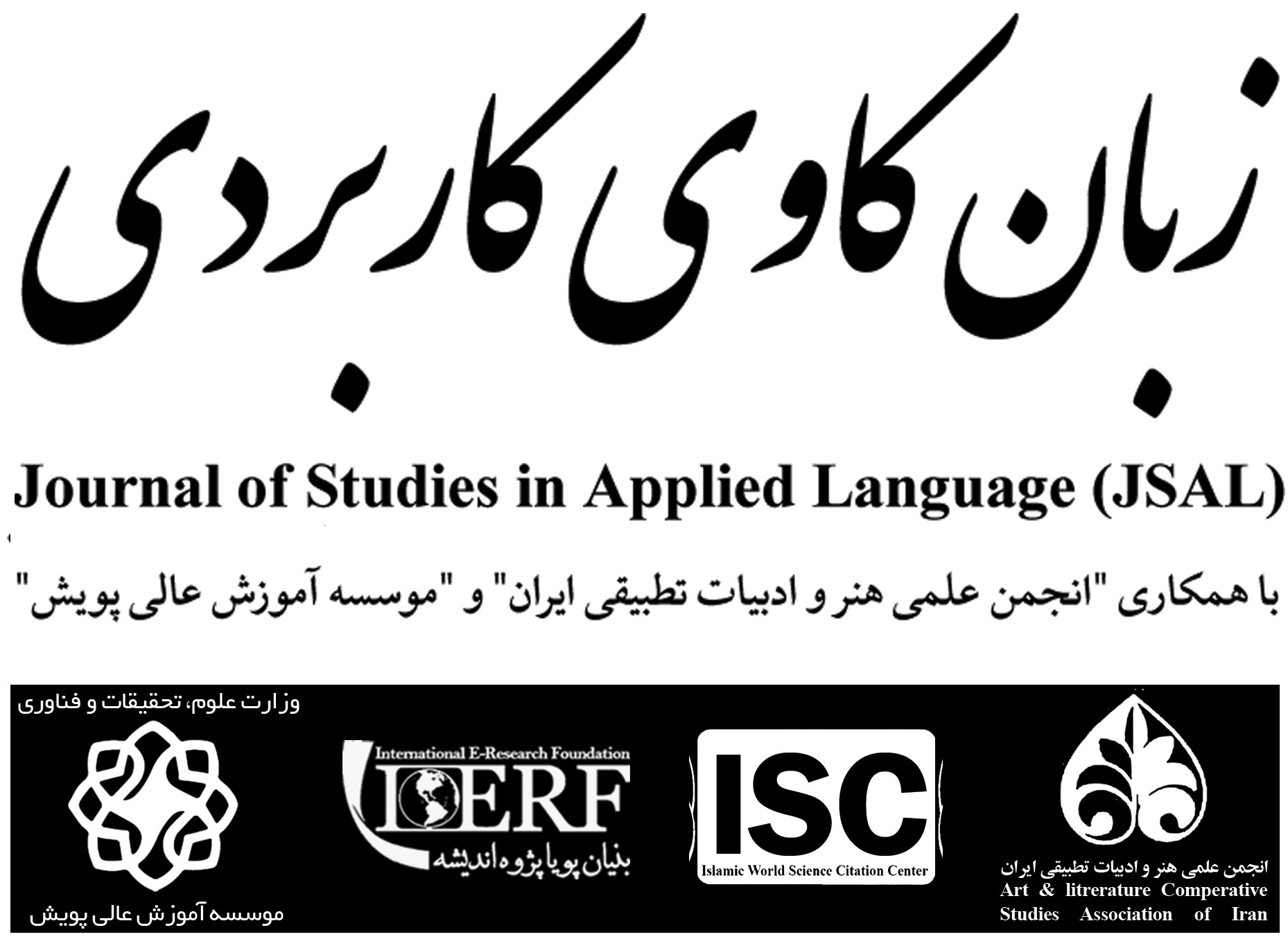<>
Volume 6, Issue 2 (4-2023)
JSAL 2023, 6(2): 63-100 |
Back to browse issues page
Download citation:
BibTeX | RIS | EndNote | Medlars | ProCite | Reference Manager | RefWorks
Send citation to:



BibTeX | RIS | EndNote | Medlars | ProCite | Reference Manager | RefWorks
Send citation to:
Seifi T, Reisi F. (2023). The Representation of Ideology in Ibn Arandas Helli's Lamia, based on the layer of thought [In Persian]. JSAL. 6(2), 63-100. doi:10.52547/jsal.6.2.63
URL: http://jsal.ierf.ir/article-1-30-en.html
URL: http://jsal.ierf.ir/article-1-30-en.html
1- Assistant Professor, Department of Arabic Language and Literature, Faculty of Literature and Humanities, Shahid Beheshti University, Iran
2- Master's student of Arabic language and literature, Faculty of Literature and Humanities, Shahid Beheshti University, Iran ,raeisi_faezeh@yahoo.com
2- Master's student of Arabic language and literature, Faculty of Literature and Humanities, Shahid Beheshti University, Iran ,
Abstract: (3813 Views)
Language conveys an ideology that is sometimes derived from the collective beliefs of a group, which manifests itself at various levels of manner and speech. Each disposition will be expressed in its language. The poet says his ideology by selecting the linguistic structures that regulate the poem, including the hidden and apparent references in the text of the words and codes, and by choosing a specific type of syntactic structures and aesthetic-rhetorical secrets. The layer of thought of the style is investigated as part of the layered stylistics approach, which is employed to realize this ideology. Ibn al-Arandas is one of the greatest Shiites and devout poets of the ninth century AH. Lamia is one of his most well-known compositions; analyzing it from a stylistic perspective helps the audience to comprehend the composer's thought process and the intricate relationship between literary techniques and external characteristics and themes. Consequently, using the descriptive-analytical method, this article examines the written principles of thought by Ibn al-Arandas across five lexical, syntactic, rhetorical, phonetic, and ideological layers. Exploring the meanings and structure of the verses and the reflection of ideology in each of the layers above led the authors to conclude that the role of the rhetorical layer was complex. Comparing Lamia to the characteristics of a literary text and an ideological text along five axes revealed no apparent conflict between literature and ideology. Lamia is not simply a thought or a literary text but serves both purposes. In addition, based on the analysis of ideology and artistic individuality in this poem, the ideology that governs Lamia is founded on significant collective values and insists on collective opinions and shared beliefs. Ibn al-Arandas uses literature to convey and strengthen his ideology to the greatest extent feasible.
Type of Study: Research |
Subject:
Discourse Analysis
Received: 2022/05/30 | Accepted: 2022/07/28 | Published: 2023/04/22
Received: 2022/05/30 | Accepted: 2022/07/28 | Published: 2023/04/22
References
1. Ibn Abi al-Hadid, A., (Not Date), Explanation of Nahj al-Balagheh, Qom: Marashi library
2. Amin, S., (1982), Shiite Notables, researched by Hassan Al-Amin, Beirut: Dar Al-Ta'rof Publication.
3. Al-Amini Al-Najafi, A., (1993), Al-Ghadeer in the Book, Tradition and Literature, Lebanon: Al-Alamy Publication.
4. Egleton, T., (2004), Marxism and Literary Criticism, translated by Akbar Masoum Beghi, Tehran: Diger Publication.
5. Al-Bukhari, M., (2001), Collective of Al-Musnad Al-Sahih Al-Bukhari, researched by: Muhammad Zuhair bin Nasser Al-Nasser, 1th edition, Dar Touq Al-Najat Publication.
6. Bin Ziril, A., (2006), Language and Style, reviewed and presented by Hassan Hamid, Amman: Majdalawi, Jab Doum.
7. Jurjani, A., (Not Date), Dalael Al-Ejaz, Cairo: Publications by Syed Rashid Rida.
8. Al-Jundi, A., (Not Date), The Art of Al-jenas, Egypt: Dar Al-Fikr Al-Arabi.
9. Al-Juweyni Al-Khorasani, I., (2007), Faraed Al-Samtain, Researched by Muhammad Baqir Al-Mahmoudi, Dar Al-Jib SaderPublications .
10. Jahandideh, S., (2017), "Critical analysis, insinuation and ideology, with emphasis on comprehensive poetry", Theoretical Studies and Literary Types, Vol. 4, pp. 149-176.
11. Al-Hamawi, T., (2004), khazana Al-Adab and gayat Al-Arab, Research by Kawkab Diab, Beirut: Dar Al-SaderPublications.
12. Al-Khaqani, A., (1993), Poets of Hilla or the Babeliyat, Najaf: Dar Al-Bayan Publications.
13. Al-Khasibi, A., (2010), Al-Hidaya Al-Kobra, Research: Sheikh Mustafa Subhi Al-Khidr Al-Homsi, Beirut: Al-Alamy Publishing Company.
14. Dorpar M. (2015) "The Arguable Stylistic Layers in Critical Stylistics of Short Story and Novel". LRR, Vol. 5, No. 5, pp. 65-94.
15. Al-Deilami, A., (2003), Irshad Al-Qulub, Researched by Sayed Hashem Al-Milani, Iran: Dar Al-Aswa for printing and publishing.
16. Al-Reihani, M., (1998), Time analysis approaches in language studies, Cairo: Dar Quba for printing, publishing and distribution.
17. Shamisa, S., (1994), Generalities of stylistics, 2 th edition,Tehran: Ferdous Publications, Chap Dom.
18. Safavi, K., (2018), An introduction to semantics, 6 th edition, Tehran: Publications of Sure Mehr Publications.
19. Taha Hamida, A., (2009) Adab Al-Shia, 3th editon, Egypt: Al-Sahada Press Publications, third edition.
20. Askari, M., (2002), The Guardianship of Ali in the Noble Qur'an and Messenger Sunnah (PBUH), Tehran: Munir Publications.
21. Al-Fassi Al-Fahri, A., (1990), Corresponding structure, A Theory of Word Building and Syntax, Dar Toubgal Publications.
22. Fotouhi, M., (2011), Stylistics, theories, approaches and methods, Tehran: Sokhan Publications .
23. Farshidward, K., (2003), Dastour Mufassal Emruz, Tehran: Sokhan Publications.
24. Ferkelaf, N., (1989), Critical Analysis, Translated by Fatemeh Shaisteh Piran and Hamkaran, Tehran: Farhang and Ershad Islamic Ministry Publications.
25. Al-Majlisi, M. B., (1982), Bahar Al-Anwar, 2th edition, Al-Wafaat Foundation.
26. Al-Mazi, J., (2021), Tahdheeb al-Kamal fi Asma' al-Rijal, Researcher: Dr. Bashar Awwad Maarouf, 1th edition, Beirut: Al-Risala Foundation,
27. Natel Khanlari, P., (1973), The Persian grammar", 2th edition, Tehran: Publications of the Buildings of Farhang Iran.
28. Al-Hashemi, S., (2004), Jawaher Al-Balagheh, translated by Hassan Irfan, Qom: Balaghat.
Send email to the article author
| Rights and permissions | |
 |
This work is licensed under a Creative Commons Attribution-NonCommercial 4.0 International License. |








